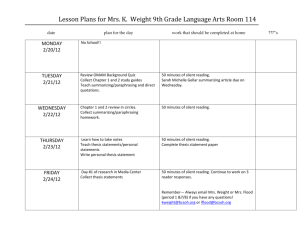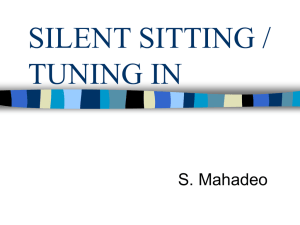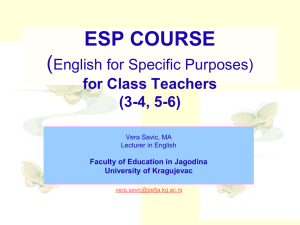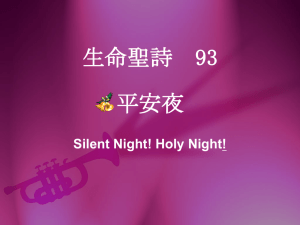Culture Rubric
advertisement
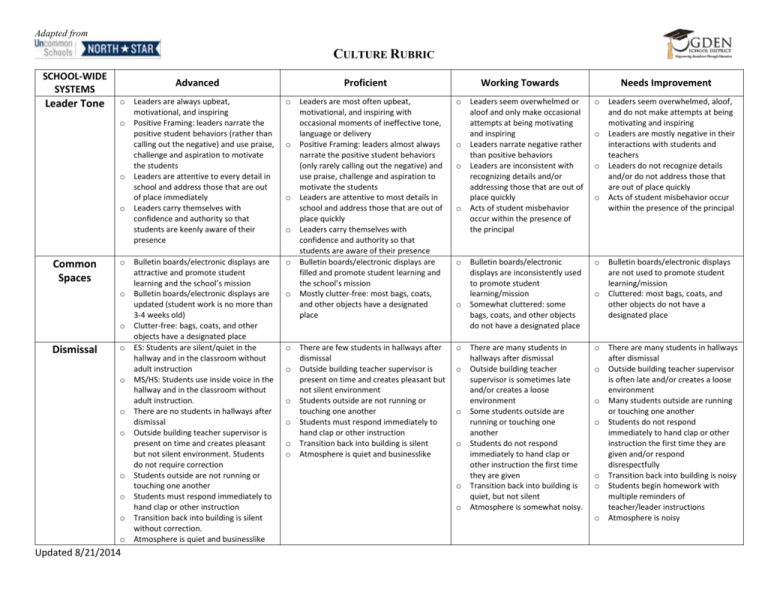
Adapted from CULTURE RUBRIC SCHOOL-WIDE SYSTEMS Leader Tone Advanced o o o o Common Spaces o o o Dismissal o o o o o o o o Updated 8/21/2014 Proficient Leaders are always upbeat, motivational, and inspiring Positive Framing: leaders narrate the positive student behaviors (rather than calling out the negative) and use praise, challenge and aspiration to motivate the students Leaders are attentive to every detail in school and address those that are out of place immediately Leaders carry themselves with confidence and authority so that students are keenly aware of their presence o Bulletin boards/electronic displays are attractive and promote student learning and the school’s mission Bulletin boards/electronic displays are updated (student work is no more than 3-4 weeks old) Clutter-free: bags, coats, and other objects have a designated place ES: Students are silent/quiet in the hallway and in the classroom without adult instruction MS/HS: Students use inside voice in the hallway and in the classroom without adult instruction. There are no students in hallways after dismissal Outside building teacher supervisor is present on time and creates pleasant but not silent environment. Students do not require correction Students outside are not running or touching one another Students must respond immediately to hand clap or other instruction Transition back into building is silent without correction. Atmosphere is quiet and businesslike o o o o o o o o o o o Working Towards Leaders are most often upbeat, motivational, and inspiring with occasional moments of ineffective tone, language or delivery Positive Framing: leaders almost always narrate the positive student behaviors (only rarely calling out the negative) and use praise, challenge and aspiration to motivate the students Leaders are attentive to most details in school and address those that are out of place quickly Leaders carry themselves with confidence and authority so that students are aware of their presence Bulletin boards/electronic displays are filled and promote student learning and the school’s mission Mostly clutter-free: most bags, coats, and other objects have a designated place o There are few students in hallways after dismissal Outside building teacher supervisor is present on time and creates pleasant but not silent environment Students outside are not running or touching one another Students must respond immediately to hand clap or other instruction Transition back into building is silent Atmosphere is quiet and businesslike o o o o o o o o o o o Needs Improvement Leaders seem overwhelmed or aloof and only make occasional attempts at being motivating and inspiring Leaders narrate negative rather than positive behaviors Leaders are inconsistent with recognizing details and/or addressing those that are out of place quickly Acts of student misbehavior occur within the presence of the principal o Bulletin boards/electronic displays are inconsistently used to promote student learning/mission Somewhat cluttered: some bags, coats, and other objects do not have a designated place o There are many students in hallways after dismissal Outside building teacher supervisor is sometimes late and/or creates a loose environment Some students outside are running or touching one another Students do not respond immediately to hand clap or other instruction the first time they are given Transition back into building is quiet, but not silent Atmosphere is somewhat noisy. o o o o o o o o o o o Leaders seem overwhelmed, aloof, and do not make attempts at being motivating and inspiring Leaders are mostly negative in their interactions with students and teachers Leaders do not recognize details and/or do not address those that are out of place quickly Acts of student misbehavior occur within the presence of the principal Bulletin boards/electronic displays are not used to promote student learning/mission Cluttered: most bags, coats, and other objects do not have a designated place There are many students in hallways after dismissal Outside building teacher supervisor is often late and/or creates a loose environment Many students outside are running or touching one another Students do not respond immediately to hand clap or other instruction the first time they are given and/or respond disrespectfully Transition back into building is noisy Students begin homework with multiple reminders of teacher/leader instructions Atmosphere is noisy Adapted from CULTURE RUBRIC CLASSROOM SYSTEMS Entry Advanced Proficient Working Towards Needs Improvement o 90-100% of students enter the classroom in less than one minute o 100% of teachers greet 100% of their students with a handshake and/or greeting o All teachers ensure that 100% of students give eye contact and return the greeting. Students that do not comply are asked to re-greet o 100% of students enter the classroom and follow set directions or classroom routines o 100% of teachers are standing at the door waiting to receive students for their next class o 100% of classes start on time or within 2 minutes of receiving class o 90% of teachers notice 100% of student compliance issues (i.e. dress code issues, manners, etc.) o 80-90% of students enter the classroom in less than one minute o 90% of teachers greet 100% of their students with a handshake and/or greeting o 90% of teachers ensure that 100% of students give eye contact and return the greeting. Students that do not comply are asked to re-greet o 90% of students enter the classroom and follow set directions or classroom routines o 90% of teachers are standing at the door waiting to receive students for their next class o 90% of classes start on time or within 2 minutes of receiving class o 80% of teachers notice 100% of student compliance issues (i.e. dress code issues, manners, etc.) o 80-90% of teachers display evidence of a system for distributing/collecting work that is efficient and routinized o 80-90% of students are silent or engaged in an activity while work is being collected or distributed o 70-80% of students enter the classroom in less than one minute o 70-80% of teachers greet 100% of their students with a handshake and/or greeting o 80% of teachers ensure that 100% of students give eye contact and return the greeting. Students that do not comply are asked to re-greet o 80% of students enter the classroom and follow set directions or classroom routines o 80% of teachers are standing at the door waiting to receive students for their next class o 80% of classes start on time or within 2 minutes of receiving class o 70% of teachers notice 100% of student compliance issues (i.e. dress code issues, manners, etc.) o 70-80% of teachers display evidence of a system for distributing/collecting work that is efficient and routinized o 70-80% of students are silent or engaged in an activity while work is being collected or distributed o Less than 70% of students enter the classroom in less than one minute o Teachers rarely greet students o Less than 70% of students enter the classroom and follow set directions or classroom routines o Less than 70% of teachers are standing at the door waiting to receive students for their next class o Less than 80% of classes start on time or within 2 minutes of receiving class o Less than 70% of teachers notice 100% of student compliance issues (i.e. dress code issues, manners, etc.) Distributing/ o 90-100% of teachers display evidence of a system for distributing/collecting Collecting work that is efficient and routinized Work & Lesson o 90-100% of students are silent or Materials engaged in an activity while work is being collected or distributed Updated 8/21/2014 o Less than 70% of teachers display evidence of a system for distributing/collecting work that is efficient and routinized o Less than 70% of students are silent or engaged in an activity while work is being collected or distributed Adapted from CULTURE RUBRIC CLASSROOM SYSTEMS Advanced Proficient Working Towards Needs Improvement Transition between activities o Efficient, time-saving (30 sec) routine o Silent or the talking is directly connected to the content o Teacher initiated using economy of language (Teacher says “transition” and students move) o Immediately after the transition students begin task o Evidence of a routine o Efficient, time-saving (up to 1 min) routine o Silent or the talking is directly connected to the content o Teacher facilitated o After the transition students are waiting for directions o Evidence of a routine Exit from Class o Class ends on time with sufficient time to line up students o Teacher uses a consistent system to have students line up that is efficient o Teacher ensures that the students are silent before leaving for the next class o Orderly transition that begins with dismissal by teacher o ES: During the transition the students remain silent without teacher o Secondary: Students are using inside voice in line o ES: Hallways are silent/quiet o MS/HS: 100% Students are using inside voice during transition o 100% of students make transition to class within the given amount of time o All students are walking urgently to class o Class ends on time o Teacher uses a consistent system to have students line up that is organized, quick and efficient o ES: Students are silent in line o ES: During transition the students may need reminders to stay silent in line o Inefficient, more than one minute o Off task talking, too noisy o Teacher has to repeat directions o After the transition students are off task o Not a clearly established routine, teacher has to redo the transition o Class ends in a rushed or hurried way or goes over time o Teacher lines students up in disorganized way, or does not check to see that all students are ready to be lined up o ES: Students are talking in line o ES: During the transition students are not silent o Inefficient, more than one minute o Off task talking, too noisy o Teacher has to repeat directions o After the transition students are off task o Not a clearly established routine, teacher has to redo the transition o Class ends late or in a rushed or hurried way o No evidence of systematic process to have students line up o ES: Students are openly talking in line o Students are loud and disorganized during the transition o ES: 90% of the students are silent/quiet o MS/HS: 80% Students are using inside voice during transition o 95% of students make transition to class within the given amount of time. Students who don’t receive a clear consequence. o Most students are walking urgently to class o ES: 75% of the students are silent/quiet o MS/HS: 70% Students are using inside voice during transition o 90% of students make transition to class within the given amount of time. Students who don’t receive a clear consequence. o Students are inconsistently walking to class o ES: Below 75% of the students are silent/quiet o MS/HS: Less than 70% Students are using inside voice during transition o Less than 90% of students make transition to class within the given amount of time. Students who don’t receive a clear consequence. o Students are running or roughhousing on the way to class o Students are purposely walking slowly to class Transitions between classes Updated 8/21/2014 Adapted from CULTURE RUBRIC CLASSROOM SYSTEMS Classroom Environment Advanced Proficient Working Towards Needs Improvement Attractiveness – 100% of classrooms are: o Clutter-Free: clean with effective storage for materials, supplies, etc. o Desk configuration makes sense and is not too tight/loose o Teacher desk and surrounding area are clean and well-organized o Classroom libraries (when applicable) are well organized and appealing to student readers Attractiveness – 90% of classrooms are: o Mostly Clutter-Free: general cleanliness and storage for materials, supplies, etc. o Desk configuration makes sense and is not too tight/loose o Teacher desk and surrounding area are generally clean and organized o Classroom libraries (when applicable) are organized Attractiveness – 70% of classrooms are: o Mostly Clutter-Free: general cleanliness and storage for materials, supplies, etc. o Desk configuration makes sense and is not too tight/loose o Teacher desk and surrounding area are generally clean and organized o Classroom libraries (when applicable) are organized Attractiveness – Most classrooms are: o Cluttered: disorganized and little storage for materials/supplies o Desk configuration doesn’t make sense o Teacher desk area is generally unorganized o Classroom libraries (when applicable) are organized Walls—90% of classroom walls have: o Posted agenda, objectives & HW o Signage supports learning objectives o High quality student work posted o Instructional signage Walls—70% of classroom walls have: o Posted agenda, objectives & HW o Signage supports learning objectives o High quality student work posted o Instructional signage Other systems—90% of classes have: o Clear systems for student work, extra assignment copies, and plan for purged work o Most student bags and coats have a place Other systems—70% of classes have: o Clear systems for student work, extra assignment copies, and plan for purged work o Most student bags and coats have a place Walls—100% of classroom walls have: o Posted agenda/schedule/objectives/HW o Signage supports learning objectives o High quality student work posted o Instructional signage: word wall organized by content, unit or alphabetical; process steps Other systems—100% of classes have: o Clear, effective systems for student work, extra assignment copies, and plan for purged work o Student bags and coats have a place Updated 8/21/2014 Walls—Most classroom walls do not have: o Posted agenda, objectives & HW o Signage supports learning objectives o High quality student work posted o Instructional signage Other systems—Most classes have: o No systems for student work, extra assignment copies, etc. o Student bags and coats do not have a place Adapted from CULTURE RUBRIC TEACHER PROFICIENCIES Positive Framing and Teacher Tone Advanced o o o Student Joy & Engagement o o o o Strong Voice o o o o o Updated 8/21/2014 Proficient 90-100% of teachers are upbeat, positive, motivated, and inspiring in the classroom The general tone of classroom is efficient, respectful and positive Frequently narrates positive student behaviors (rather than calling out the negative) and uses praise, challenge and talking aspiration to motivate the students o Students seem to be joyful and excited to be in school 90% of students are engaged in classroom activities Older students internalize and model behavioral expectations without teacher supervision 100% of students exhibit professional posture o Economy of language: minimal language is used to build student compliance Don’t talk over students: adults never talk over student chitchat Do not engage: adults never engage student excuses/distractions during correction of student misbehavior Non-verbal authority: adults always use square up/stand still and proximity to maintain student compliance Quiet power: teacher always speaks slowly and quietly to develop compliance o o o o o o o o o o Working Towards 75-90% of teachers are upbeat, positive, motivated, and inspiring in the classroom The general tone of the classroom is efficient, respectful and positive Narrates positive student behaviors (rather than calling out the negative) and uses praise, challenge and talking aspiration to motivate the students o Most students seem to be joyful and excited to be in school 80-90% of students are engaged in classroom activities Older students internalize and model behavioral expectations with minimal teacher supervision 90% of students exhibit professional posture o Economy of language: minimal language is used to build student compliance Teachers/leaders rarely allow student side conversations while talking Teachers/leaders rarely engage student excuses/distractions during correction of student misbehavior Non-verbal authority: adults almost always use square up/stand still and proximity to maintain student compliance Quiet power: teacher almost always speaks slowly and quietly to develop compliance o o o o o o o o o o Needs Improvement 60-75% of teachers are upbeat, positive, motivated, and inspiring in the classroom The general tone of the classroom is inconsistent in efficiency, respectfulness, and positivity Does not use positive framing OR narrates negative student behaviors as often as positive OR teacher does not use positive framing and inconsistently uses praise, challenge or aspiration to motivate students While many students seem joyful, there are notable instances of student arguments and/or lack of joy 70-80% of students are engaged in classroom activities The older students have not internalized behavioral expectations and are resistant to those expectations 70% of students exhibit professional posture o More language is used than needed to build student compliance Teachers/leaders sometimes allow student side conversations while talking Teachers/leaders sometimes engage student excuses/distractions during correction of student misbehavior Non-verbal authority: adults sometimes use square up/stand still and proximity to maintain student compliance Quiet power: teacher sometimes speaks slowly and quietly to develop compliance o o o o o o o o o o o Most teachers are uninspiring and/or negative in the classroom The general tone of classroom is inefficient and/or negative Does not use positive framing, and does not work to motivate students Students generally seem disinterested in school Less than 70% of students are engaged in classroom activities The older students have not internalized behavioral expectations and are more resistant to those expectations than younger students Less than 70% of students exhibit professional posture Teachers are so verbose that students do not understand compliance requested Student side conversations often occur while teacher is talking Teachers/leaders often engage student excuses/distractions during correction of student misbehavior Non-verbal authority: adults rarely use square up/stand still and proximity to maintain student compliance Quiet power: teacher rarely speaks slowly and quietly to develop compliance Adapted from CULTURE RUBRIC TEACHER PROFICIENCIES What to Do Advanced o o Directions are specific, concrete, sequential, observable steps; steps are small enough that every student easily complies Narrate compliance instead of telling what not to do Proficient o o 100% o o o o Student Response to Correction o o o o o Least invasive interventions (mostly non-verbal, group reminders, positive framing) Less than 10% of class time is spent on redirecting students 100% of students are on task during group work 100% of students are able to answer upon being cold-called o Immediate Silent Teacher correction is accomplished through direct eye contact Positive/respectful Behavior does not reoccur within the same period o o o o o o o o Working Towards Directions are specific, concrete, sequential, observable steps; sometimes more specific steps need to be offered if a few students do not comply on first attempt Narrate compliance instead of telling what not to do Least invasive interventions (mostly non-verbal, group reminders, positive framing) 20% of class time spent redirecting students 90% of students are on task during group work 90% of students are able to answer upon being cold-called o Fairly quick Silent Teacher correction is nonverbal (tap on the desk, hand signal, etc.) Neutral/respectful Behavior does not reoccur within the same period o o o o o o o o o o o Needs Improvement Directions sometimes lack being specific, concrete, sequential and/or observable More specific directions are not offered if students do not comply Teacher sometimes narrates what not to do o Teacher mostly uses invasive interventions (verbal reminders and redirects; too much teacher talk) 40% of class time spent redirecting students 80% of students are on task during group work 80% of students are able to answer upon being cold-called o There is wait time before the action is corrected Teacher correction is verbal Student responds but not immediately Student responds negatively, but corrects action (rolls eyes, sucks teeth, sigh) Student action has to be corrected multiple times within a period o o o o o o o INSERT SCHOOL SPECIFIC FOCAL AREA o o o o INSERT SCHOOL SPECIFIC FOCAL AREA o o o o Updated 8/21/2014 Directions are vague and difficult to follow/understand Teacher often narrates what not to do Teacher uses all invasive interventions (verbal reminders and redirects; too much teacher talk; rhetorical questions) 60% of class time spent redirecting students Less than 80% of students are on task during group work Less than 80% of students are able to answer upon being coldcalled Student doesn’t respond Student talks back (open defiance) Student only responds after the threat of a serious consequence

